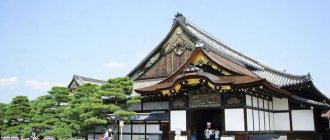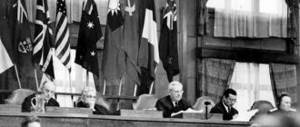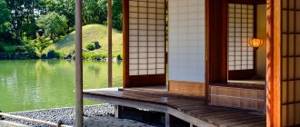The Hour of Truth: Emperor Meiji's Japan
The program “Hour of Truth” made a number of episodes about Japanese eras.
Here is an episode dedicated to the Meiji period. A. Meshcheryakov takes part in the program, which gives it a very good position in terms of consecration and assessment of events. Overall a pretty informative episode. I recommend. However, if you are in the know, then nothing new... Good overview show.
Russo-Japanese War: reasons
Here is the first part of my video course. It covers the causes of the Russo-Japanese War.
Russo-Japanese War: course of events and results
Here is the second part of my video course on the history of the Russian-Japanese War. The video review covers the course of events and the results of the Russo-Japanese War
Mikhail Kozhukhov again tells the most mysterious things about Japan!
Golden Globe. Japan
The film shows the most beautiful places and buildings in Japan.
In search of adventures with Mikhail Kozhukhov
Japan is the most mysterious country in the world. They simply value their thousand-year-old traditions, unlike other nations.
Geisha world
We have already written about the fate of geishas during the Meiji period . Here is a documentary film covering two world wars. The film is old - 1999. Country of origin: Great Britain. The British know how to get to the bottom of things.
Samurai bow - Japanese edged weapon
On this site we have already started talking about samurai, because they had a monstrously huge impact on the history of Japan. I bring to your attention a very educational documentary about such Japanese edged weapons as the samurai bow. This Japanese weapon influenced not only the history of Japanese military affairs, but also the traditions of the Land of the Rising Sun, which continue to live to this day...
Ninja.
The film tells the story of the origins of the ninja. What I like about it is that it gives opinions from different people. It also briefly mentions the Meiji period. You can also read about ninjas during the Meiji period.
Feature film The Shadow Samurai.
It tells from the situation that developed in Japan in the mid-19th century from the point of view of a low-ranking samurai. About the struggle of clans and the fact that in this struggle everyone had to make their own choice on which side to be on. A low-ranking samurai finds himself drawn into this struggle, who, in order to feed his family, must also make his own difficult choice...
Japan 2002.
Feature film The Last Samurai
The film tells the story of the split situation that developed at the beginning of the Meiji period. An experienced gaijin is hired to quell the discontent of some of the samurai. With his consent, the difficult fate of a foreigner in Japan begins.
USA 2003.
Feature film “The Last Sword of the Samurai”
The film tells the story of an unusual hero of his time: a samurai who was, on the one hand, a mercantile and caring father, and on the other, an unyielding warrior who had to make his choice on whose side to fight at the beginning of the Meiji era.
Japan 2003.
Feature film “Port Arthur. Height 203″.
The film tells about the siege of the Russian fortress of Port Arthur by Japanese troops during the Russo-Japanese War. War drama. Japan 1980
Feature film “Red Sun”
The film tells about the adventures of a cowboy and a samurai.
Feature film “Samurai. The path is war"I consider the film about Miyamoto Musashi, a harsh samurai of the Tokugawa period (1603 - 1867), one of the best films about samurai ever made. Although this site is dedicated to the Meiji period (1868 - 1912), I nevertheless consider it necessary to publish this film trilogy here. Why? The key thesis of this site: the samurai did not disappear during the Meiji period, and their traditions and customs were adopted by the entire Japanese society. Therefore, both for understanding the psychology of the Japanese of our time, and for immersing ourselves in the culture of the Land of the Rising Sun, Bushido I consider this film extremely useful for viewing. Country: Japan. Years: 1954 – 1956. Starring Toshiro Mifune. Samurai. Feature film “Zatoichi”The film tells the story of a traditional Japanese cinema hero - a blind samurai who shreds everyone in this way. Of course, classic Japan is shown - the Tokugawa period. If you have a question why there are so many samurai films on the site, look here . Film by Takeshi Kitano. Japan 2003. |
The whole course in 5 minutes
Course by Alexander Meshcheryakov “How to understand Japan” in a brief summary
Game of Go. 19th century © Okinawa Soba / flickr.com
What do the Japanese think about themselves?
Today the Japanese consider their country small, without any advantages - rich resources, wonderful climate. But they didn't always think that way. Before foreigners arrived on the island, the Japanese had a completely different opinion about their country. For more information, see the episode “What the Japanese Think of Themselves.”
History of Japan in 20 points
“The typhoon buried most of the huge Mongol fleet and plans to conquer Japan. These campaigns are associated with the emergence of the concept of kamikaze, which literally translates as “divine wind.” Read about the main historical events in Japan in the cheat sheet “History of Japan in 20 points.”
Discovery of Fuji
Before Europeans recognized Fuji as the most beautiful mountain in the world, it never occurred to the Japanese to admire its view or go to the mountains for any reason other than to pray. About the changing meaning of the main Japanese mountain - in the episode “Discovery of Fuji”.
A Brief History of Love and Hate for Europeans
“Mastering the musket and understanding the principles of its design took place not without the help of the categories of Eastern philosophy. Thus, the secret of a well-aimed shot from a musket, according to the treatise “Teppoki”, was “straightening the heart and squinting the eye” - read the material about the complex history of relations between Japan and the West.
Russian-Japanese relations in cinema
Russian landscapes, the love of fragile blue-eyed girls and visa regimes - in a selection of films about Russian-Japanese relations.
What did the Japanese take from the Chinese and how did they change it?
“The ability to compose poetry in Chinese is one of the duties of Japanese officials in ancient times and the Middle Ages.” What else the Japanese borrowed from China and how they changed it to suit their own needs - in the “Relationships” section.
Nine Key Concepts to Help You Understand Japanese Culture
“Matsuo Basho was asked what sabi was, he replied that he imagined an old man putting on ceremonial clothes to go to the palace. Basho never gave clear definitions; he spoke metaphorically, dropping cryptic phrases full of hidden meanings, which his students then interpreted.” Text by translator Elena Dyakonova about untranslatable Japanese concepts.
How to Love Japanese Traditional Music
Japanese traditional music was borrowed from China along with Buddhism and palace ceremony. And although it had nothing to do with the ancient beliefs of the Japanese, or with Buddhism itself, it took root very well in Japan (and in China, on the contrary, it gradually disappeared). The Japanese sometimes perform gagaku during weddings. You can try to fall in love with music, the closest analogue of which in our culture is the anthem, using our instructions with examples.
Rice and fish
Why were the Japanese tied to the land and reluctant to move? How do they feel about tuna? What kind of rice is healthy to eat? Does Japan consider itself a maritime power? The answers to these questions are in the episode “Rice and Fish”.
Sakura. Elusive beauty
Sakura is Japan's favorite tree and inspires poetry, painting, painting, tears or drinking. How it happened that she was replaced by a crooked pine tree - in the episode “Sakura. Escaping beauty."
Japanese etiquette
Japanese politeness and bowing serve to maintain hierarchy in society. Ideally, there are no two people of equal status. How this relates to the relative peace-loving nature of the Japanese - in the episode "Japanese Etiquette".
How to Read and Understand Haiku
“Haiku is least of all a description. It is necessary not to describe, the classics said, but to call things in extremely simple words and as if you are calling them for the first time... The main thing in the haikaist’s worldview is an acute personal interest in the form of things, their essence, and connections.” Basho’s recommendations “Learn from the pine tree, what pine is, learn from bamboo, what bamboo is” and other tips on how to read and understand haiku.
Major works of Japanese literature
“The feathered dress, the dress of oblivion: you put it on and you forget everything completely” is a very ancient image that came to Japan from Southeast Asia, just one of the images that can be gleaned from Japanese classical literature. Our list contains the fifteen most important texts for every cultured person in Japan.
Secrets of the greatness of the main works of Japanese art
“The shape of the Iris bowl is simple and irregular. The slight curvature of the walls and the dents from the potter’s hands visible throughout the body impart an almost naive ease to the bowl. The clay shard is covered with a light glaze with a network of cracks.” Why an artless teacup is considered the greatest work of art - as an art historian explains the secrets of the greatness of the main works of Japanese art.
What do the Japanese believe?
A short guide to Japanese beliefs: how to communicate with kami deities, what replaces the concept of “sin” in Shintoism, and why you shouldn’t throw Buddha into a ditch - in the text “What the Japanese Believe.”
Film Laboratory of Death. Apocalypse in Japanese watch online
In the late 30s and early 40s, Japan was actively preparing for the outbreak of World War II. Occupied Manchuria became a springboard for aggression against the USSR. In the vicinity of the closed city of Russian emigrants, Harbin, people began to disappear. Japanese gendarmes detained men and women on suspicion of various crimes, but did not send them to prison. Inhumane experiments and horrific torture were carried out on the territory of Harbin. Prisoners were infected with syphilis, their arms were amputated and sewn to the opposite side of the body. These terrible experiments had much in common with the crimes of the notorious Nazi scientist Josef Mengele. The danger threatened not only the residents of Harbin. It was here that the Japanese authorities tested bacteriological weapons, from which both neighboring countries and all of humanity could suffer.
Cherntsy, a small village in the Ivanovo region. It was here that in the winter of 1950, high-ranking Japanese generals and officers were brought on sleighs - to a Soviet prison. But instead of solitary cells with bars on the windows, the prisoners found themselves in a beautiful estate, converted into a prisoner of war camp. Today, only ruined walls remain of the former estate, but from the surviving inscriptions on the bricks one can determine what was there before. Thanks to a recording with the story of former prison nurse Tatyana Motova, the facts have survived to this day.
Motova says that the generals were placed 2 people in a room. The nurse was required to take samples from the dishes. The prisoners played billiards in their spare time, walked, and gardened. None of the staff knew that these peaceful and calm prisoners were war criminals convicted of inhumane experiments. The trial against them was called the Khabarovsk trial, and the defendants were the leaders of Unit 731. The criminals carried out monstrous experiments using extremely cruel methods. The Japanese planned to arrange deadly epidemics on the territory of the Soviet Union, China and Mongolia, for which they conducted experiments on living people.
In January 1942, a special detachment of the Japanese army brought an artist who in ordinary life was engaged in painting kimonos. He was forced to draw terrible things: rotten arms and legs, children's bodies with amputated limbs. There was no film then, and the authors of the terrifying experiments needed a visual study of the effects of deadly bacteria. Unit 731 developed destructive weapons by observing the suffering of living people.
The Japanese themselves initiated the entry into World War II, which suited Hitler. The Japanese launched a full-scale offensive and invaded neighboring countries, but their blitzkrieg failed, as did Plan Barbarossa. By mid-1942, the Americans and British launched an offensive, and Japan could not win. Despite the lack of necessary resources, the Japanese authorities authorized the creation of bacteriological weapons, for which Unit 731 was created. The Geneva Protocol of June 17, 1925 prohibited the use of asphyxiants and bacteriological agents in war, but not all countries signed it. Hitler secretly instructed Goering to create an institute for breeding deadly bacteria. The Japanese were in contact with the Nazis. The first experiments in spraying poisons were carried out from the air over Poznań.
A special detachment of the Japanese armed forces was created in the 30s, but the country's authorities began to develop an increased interest in bacteriological weapons during the war years. The people who were used for experiments were called logs. According to one of the generals, in occupied Manchuria, 600 people annually entered the detachment for experiments. As another criminal said, he watched the girl and mother in the prison window, and then they disappeared - they were experimented with poisonous gases. The doctors cynically watched the progress of the experiment. On special maps, objects for infection with bacteria were indicated.
In the 1930s, an article was published in China about an outbreak of plague. One morning, a Japanese fighter jet dropped bags of cotton wool and grains of rice over two Chinese cities. Soon fatal diseases began. The cause of death was plague. It was this article that Shiro Ishii, a microbiologist, lieutenant general of the Japanese army and the main inspirer of the experiments, proudly showed to his subordinates. Ishii emphasized the low cost of producing bacteriological weapons, equating them with nuclear ones, and he managed to convince the authorities to create such weapons.
Shiro Ishii immediately liked the idea of dropping bombs filled with plague fleas, but the question arose: how to detonate the charge so that the fleas remained intact? One of the geishas involuntarily suggested a solution when she accidentally dropped a ceramic vase. “Detachment 731” began producing ceramic bombs, the effects of which were tested on human “logs”. Each bomb contained about 30,000 infected fleas. Those tied to the posts screamed desperately, but it was impossible to escape.
Tatyana Motova remembers a young Japanese orderly who was assigned to study bacteria on mannequins and then on living people. Members of Unit 731 fanatically served the country and believed that in doing so they were benefiting it. In the spring of 1945, Shiro Ishii ordered intensified preparations for bacteriological warfare against the USSR, which is why Unit 731 was stationed near the border.
The archival documents of the prison in Cherntsy contain correspondence from prisoners of war, in which the generals thanked the NKVD officers for their “sensitive care.” “Detachment 731” was part of the Kwantung Army, which was led by General Yamada, a seemingly sweet old man, but in fact one of the main Japanese war criminals.
The Japanese prepared for the harsh Russian climate by conducting experiments on frostbite. The situation of the front line with frostbite of soldiers was simulated. Unit 731 scientists froze part of the prisoner's arm, then cut off the arm at the elbow and froze the arm at the shoulder, after which they amputated it at the shoulder. Thus, only the head and torso remained of the person - for other, no less monstrous experiments.
In “Detachment 731” there was a so-called exemplary room, and not everyone could withstand the contemplation of the creepy exhibits. All recruits were forced to visit this room to test their courage. The Japanese were well prepared for bacteriological warfare, but did not have time to take advantage of the results of the nightmare experiments - the USSR attacked first, inflicting a crushing defeat on the Kwantung Army. The leader of Unit 731, Shiro Ishii, and his closest associates managed to escape from Harbin in time. They sought to remove all accumulated materials and, especially, strains of bacteria. What they couldn’t take out, the criminals destroyed. Shiro distributed ampoules of cyanide to his wards, which they had to take, realizing that captivity was inevitable.
On May 1946, an international tribunal in Tokyo, organized by the United States, began in Japan. One of the charges was bacteriological experiments. At first, the Americans planned to cooperate with the Russians, but later, having received evidence of the activities of Unit 731, they made a deal with the Japanese: they would not raise this point of accusation, but in return they would receive all the results of the experiments. In exchange for the papers, Shiro Ishii and other criminals became invulnerable to investigation. More than 3,600 Japanese scientists received an extended amnesty, and many received prominent positions in American universities and lived quietly into old age. Americans considered this information more important than justice in light of the Cold War. That is why the Soviet authorities initiated their trial - Khabarovsk. The main ideologists of Unit 731 were not convicted, but the whole world learned about their atrocities.
In the dock were people of different status - from a young orderly to the commander-in-chief of the Kwantung Army. The convicted received sentences from 2 to 25 years in prison. They were kept in comfort, they had their own translator, and they received excellent food. Instead of 25 years, the prisoners served only 7. They were released with the onset of the thaw. At parting, everyone was given a suit and tie and given packed lunches. With such concern, the Soviet government wanted to demonstrate its peaceful attitude towards Japan. Not all prisoners left the walls of the Soviet prison; they were buried with honors. The existence of Unit 731 and its activities have never been recognized by the current Japanese authorities.










